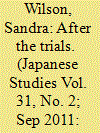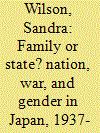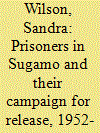|
|
|
Sort Order |
|
|
|
Items / Page
|
|
|
|
|
|
|
| Srl | Item |
| 1 |
ID:
106796


|
|
|
|
|
| Publication |
2011.
|
| Summary/Abstract |
'Lesser' Japanese war criminals, or those in Classes 'B' and 'C', were prosecuted by the various Allied powers in courtrooms around Asia after the Second World War. They were then executed or imprisoned in the places in which they had been tried. By the end of 1953, however, all surviving prisoners had been repatriated to Japan to serve out the remainder of their sentences, and by the end of 1958, all had been released. The decision to repatriate or release prisoners was made by the governments that had tried the war criminals, even after Japan regained its sovereignty in 1952, since the San Francisco Peace Treaty stipulated that the prosecuting countries retained the right to decide on any variation of the prisoners' sentences. The fate of convicted war criminals, therefore, was subject to diplomatic negotiation between Japan and the original prosecuting countries. These negotiations played an important role in the post-war reconfiguration of international relations in the East Asian region. Discussion about the repatriation and release of prisoners constituted one of the first topics of major international negotiation among a reconstructing Japan, the newly independent or decolonising nations of the region, the departing European imperial powers, a United States which was in the process of defining its Cold War aims in the region, and Australian governments seeking to establish a new foreign policy stance in the post-war world.
|
|
|
|
|
|
|
|
|
|
|
|
|
|
|
|
| 2 |
ID:
072688


|
|
|
|
|
| Publication |
2006.
|
| Summary/Abstract |
Nationalist ideology and nationalist practice in Japan between 1937 and 1945 were fundamentally conditioned by gender. For women, the proper roles of the subject were most fully elaborated through the patriotic women's associations, principally Aikoku fujinkai (Patriotic Women's Association), Kokub? fujinkai (Women's National Defense Association), and Dai Nippon fujinkai (Greater Japan Women's Association). The last of these claimed 27 million members throughout the empire. The women's associations attempted to define the ideal relation between women and the nation, primarily through an emphasis on home and motherhood. Yet, by 1945, wartime requirements had exposed basic flaws in their ideology from the state's point of view. Not only did the emphasis on home and motherhood impede the use of women in the labor force, more fundamentally, leaders of the women's associations and others realized that devotion to family might also lead to women failing to encourage their young sons to join the military. In these circumstances, a strong focus on the family, which had earlier been positively evaluated as the major part of women's gendered contribution to the war effort, came to be redefined as a form of "individualism," which had to be resisted for the national good. By this stage, "family" and "state" could no longer be taken for granted in official rhetoric as mutually reinforcing entities.
|
|
|
|
|
|
|
|
|
|
|
|
|
|
|
|
| 3 |
ID:
106798


|
|
|
|
|
| Publication |
2011.
|
| Summary/Abstract |
The great majority of Japanese war criminals served part or all of their sentences in Sugamo Prison in Tokyo, either because they had been tried in Japan, or after repatriation from overseas. Once convicted, they tended to be invisible in historical accounts of the post-war period, but in fact they were not cut off from Japanese society or politics in the 1950s. Rather, Sugamo's inmates worked hard to win public sympathy, also exerting considerable pressure on the government in an attempt to hasten their own release and to have Japanese prisoners repatriated from overseas gaols. The early 1950s were crucial, not least because the 1952 peace treaty stipulated that the countries that had originally prosecuted them retained the right to decide on prisoners' fates even after Japan regained its sovereignty. Moreover, convicted war criminals were increasingly concentrated in Sugamo, allowing many opportunities for political activity and other campaigning. Though the last war criminals were not freed until 1958, prisoners' activities in the early 1950s played an important part in changing the terms in which discussion of war criminals took place and thus in making it more and more difficult for foreign governments to maintain their original stance on war criminals.
|
|
|
|
|
|
|
|
|
|
|
|
|
|
|
|
|
|
|
|
|